 In a continued attempt to better understand the 2017 federal income tax brackets, here is a graphical breakdown of a simple scenario for a married filing joint couple with no dependents. Again, I’ll try to explore the differences in terms such as gross income, taxable income, marginal tax rate, and effective tax rate. See also:
In a continued attempt to better understand the 2017 federal income tax brackets, here is a graphical breakdown of a simple scenario for a married filing joint couple with no dependents. Again, I’ll try to explore the differences in terms such as gross income, taxable income, marginal tax rate, and effective tax rate. See also:
2017 federal income tax rates for married joint filers.
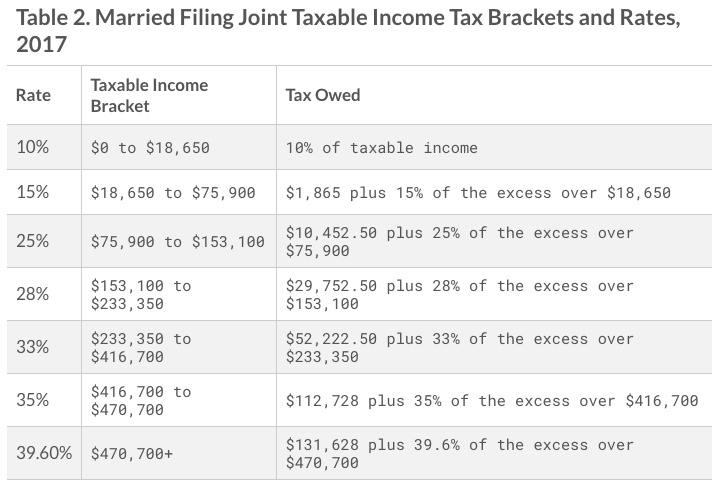
Simple example. Let’s say your combined gross income is $120,000 a year. You are a married couple with no dependents and both earn $60,000 gross income. You are both employees that receive W-2 income only (i.e. neither are self-employed). You don’t have any additional income sources like interest, capital gains, rents, etc. You don’t have any extra deductions like IRA/401k contributions or mortgage interest. You live in a state with no state income tax.
Gross income. Let’s start with your annual $120,000 gross income. You each get a personal exemption of $4,050 in 2017. You also get something called the standard deduction which is $12,700 for married filing joint in 2017. Since you don’t have a lot of itemized deductions, you use this standard deduction.
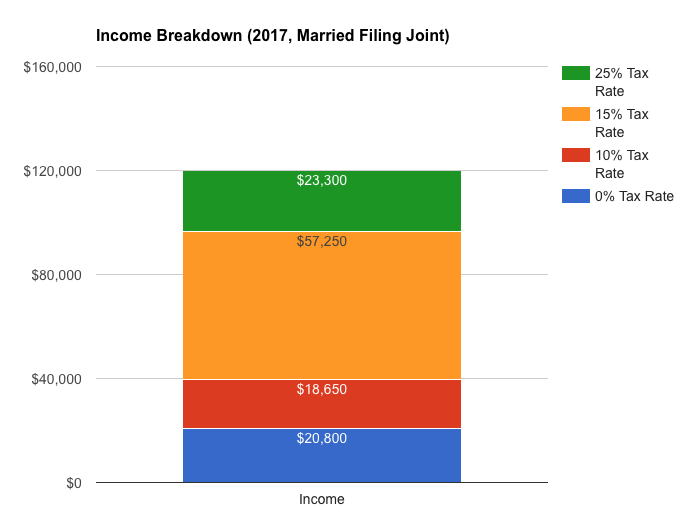
The first 20,800 of your gross income is not taxable. Without doing anything special at all, your $120,000 in gross income is now only $99,200 in taxable income after personal exemptions and the standard deductions. If you’ve already done your taxes, your taxable income should be line 43 on Form 1040, line 27 on Form 1040A, and line 6 on Form 1040EZ.
The first $18,650 of taxable income is subject to a 10% tax rate. Shave off 10% of $18,650 and put that on your tax bill ($1,865). The remaining $80,550 of taxable is moved onto the next tax bracket.
The next $57,250 in taxable income is subject to a 15% tax rate. Shave off 15% of $57,250 ($8587.50) and add that to the existing $1865. The tax bill is now $10,452.50. The remaining $23,300 of taxable is moved onto the next tax bracket.
The next $77,200 in taxable income is subject to a 25% tax rate. However, we only have $23,300 left. So we shave off 25% of $23,300 ($5825) and add that to the existing $10,452.50. The total tax bill is now $16,277.50.
In this example, this 25% is your marginal tax bracket. If you earned another $1, it would be taxed at this marginal rate of 25%.
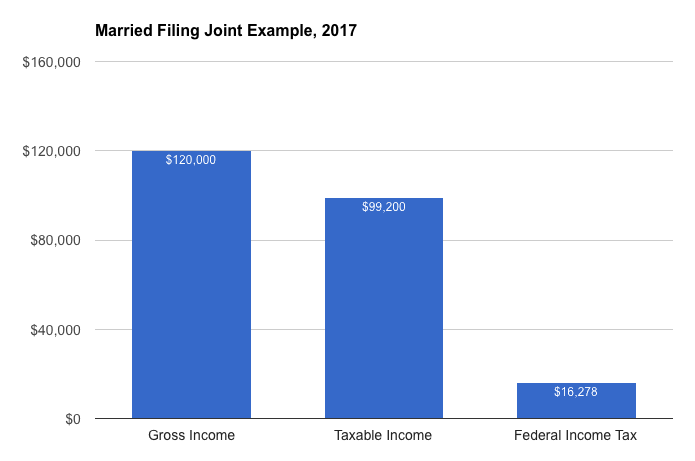
Payroll taxes. These aren’t technically federal income taxes, but you must each pay a Social Security tax (OASDI) of 6.2% and Medicare payroll tax (HI) of 1.45% of your gross income. That’s $3,720 a year for Social Security and $870 a year for Medicare. You both earn $60,000 gross and don’t exceed the income caps. (Your respective employers pay the same amount.)
Overall effective tax rate. You paid $16,278 in federal income taxes on $120,000 of income, for an average or overall effective tax rate of 13.6%. Again, you also paid 7.65% in payroll taxes. You see that two married people earning $60k each pay the same percentage in tax as a single filer earning $60k.
The “marriage penalty” usually occurs when two individuals both with either low- or high-incomes marry. The “marriage bonus” usually comes about when the incomes are quite different. For example, a single person earning $120k in gross income would pay an extra $7,000 in income tax vs. married earning $120k.
Married earning $60k gross annually. Alternatively, a married couple earning $60k gross would pay roughly $3,000 less in income tax vs. single earning $60k (and only reach the 15% marginal tax bracket). Here’s that visualization:
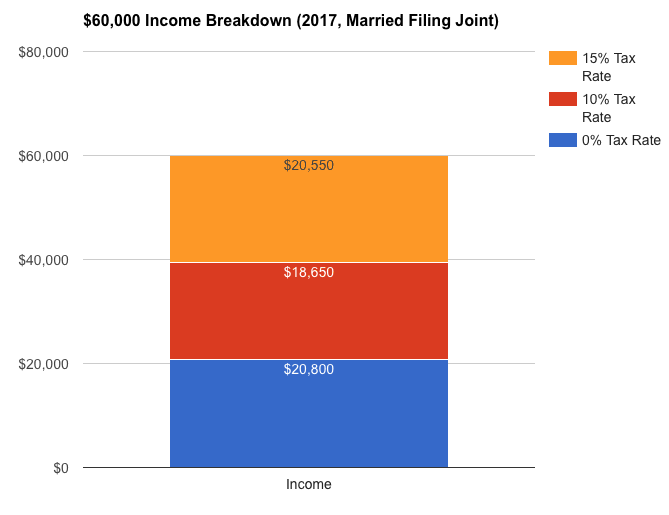
Here’s a chart from OurWorldinData.org that shows how the average tax rate changes with taxable income (2016, married filing joint).
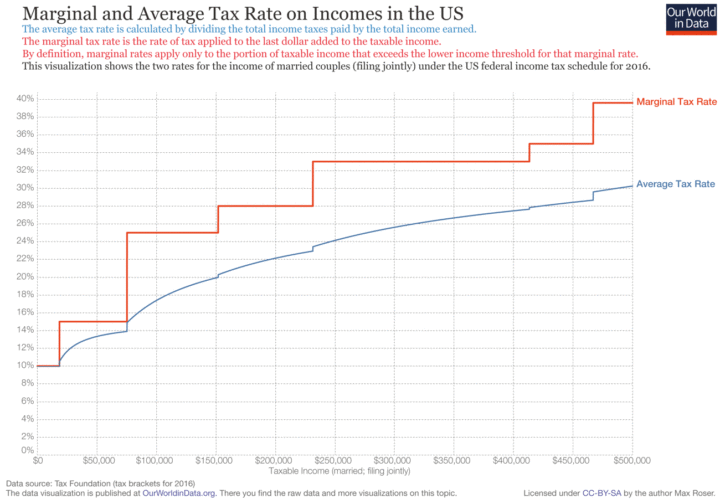
 The Best Credit Card Bonus Offers – 2025
The Best Credit Card Bonus Offers – 2025 Big List of Free Stocks from Brokerage Apps
Big List of Free Stocks from Brokerage Apps Best Interest Rates on Cash - 2025
Best Interest Rates on Cash - 2025 Free Credit Scores x 3 + Free Credit Monitoring
Free Credit Scores x 3 + Free Credit Monitoring Best No Fee 0% APR Balance Transfer Offers
Best No Fee 0% APR Balance Transfer Offers Little-Known Cellular Data Plans That Can Save Big Money
Little-Known Cellular Data Plans That Can Save Big Money How To Haggle Your Cable or Direct TV Bill
How To Haggle Your Cable or Direct TV Bill Big List of Free Consumer Data Reports (Credit, Rent, Work)
Big List of Free Consumer Data Reports (Credit, Rent, Work)
thanks.
I would like to see Married with Kid(s) tax brackets as well.
Yes, please do one more with one kid as dependent
Sure, I will work on that.
This doesn’t apply to us, but the graphics are great, and clear. Also, I just saw that you updated the family photo – love it! Hope y’all are getting some sleep 😉
Thanks for this example/explanation. It really clarifies how the chart works. I wonder if anyone can clarify how they came up with this chart.
Thank you. This is very helpful info.